Two-thirds of Linux kernel vulnerabilities come from memory safety problems, which reveals a crucial challenge developers face. The Linux kernel team made history by adding Rust support, and this transformation became official with Linux kernel version 6.1.
The Linux kernel has over 30 million lines of C code, and Rust’s addition shows a clear move toward safer memory architecture. The integration stays experimental, and developers haven’t created any production-ready in-tree drivers or modules yet. Tech giants like Amazon, Google, and Microsoft have backed this project strongly since 2019. Their support makes sense because 70% of their security vulnerabilities stem from memory corruption in their C and C++ codebases.
This piece will dive into Rust’s technical architecture in the Linux kernel. We’ll look at its current implementation status, analyze how it affects performance, and explore the development roadmap that will shape this innovative project’s future.
Memory Safety Features in Linux Kernel Rust
Rust’s integration into the Linux kernel provides reliable memory safety features through its innovative architecture design. The language excels at preventing common vulnerabilities like buffer overflows and use-after-free errors without needing garbage collection.
Zero-Cost Memory Safety Abstractions
Rust implements memory safety through zero-cost abstractions, a concept it borrowed from C++. Developers can write high-level code that compiles into machine code as efficient as hand-written low-level implementations. The kernel’s Rust API demands strict documentation requirements around unsafe code usage that will give a clear understanding of caller safety requirements and justify unsafe construct usage.
Compile-Time Ownership Checking
The ownership system is the life-blood of Rust’s memory safety architecture. Each value in Rust has one unique owner at a time. Rust deallocates memory automatically through a special function called drop when variables go out of scope. This automatic memory management helps eliminate common programming errors like double-free issues and memory leaks.
The borrow checker enforces significant rules at compile time:
- Multiple immutable references can exist for the same location
- Only one mutable reference exists at any time
- References must not outlive their referenced data
Reference Lifetime Validation
Reference lifetime validation helps memory safety by tracking reference validity periods. The Rust compiler uses a borrow checker with lifetime annotations to verify reference validity. These lifetimes prevent dangling references where programs might reference non-existent data.
The kernel uses Rust’s lifetime system to manage per-file state effectively. To name just one example, see the FileOpener::open function that returns an object and transfers lifetime ownership to the caller. On top of that, it passes non-mutable references to functions between open and release operations, which ensures thread safety through Rust’s aliasing rules.
These memory safety features have shown promising results. New Rust code shows fewer risks of memory safety bugs, data races, and logic bugs. More than that, maintainers feel confident about refactoring and accepting patches for modules, thanks to Rust’s safe subset. These safety mechanisms work without affecting the kernel’s performance, which lines up with the project’s goal to maintain high performance while improving security.
Linux Kernel Rust Architecture Design
The Linux kernel’s Rust integration has a smart architecture that connects memory-safe code with the existing kernel infrastructure. The architecture uses bindgen tool to automatically create bindings between C and Rust components when building.

Kernel Module Interface
Linux’s kernel module interface creates a framework where Rust modules work as staticlib crates and produce .a files that blend with Linux’s module build system. This design requires all shared kernel module data to implement the Sync trait. This ensures safe access when multiple user space processes run.
The interface layer has these essential components:
- Automatic generation of kernel function bindings
- Memory management abstractions
- High-level data structure interfaces
- Macro definitions for module properties
A vtable system creates function-specific boolean constants that verify function availability at runtime. C code uses these constants, which start with HAS_XXX, to check if specific Rust functions exist.
Memory Management Layer
Rust for Linux’s memory management works through a hierarchical page table system. The system can map physical memory pages as one or more virtual pages. Multiple levels of page tables handle the translation. This system supports:
- Translation Lookaside Buffer (TLB) that caches address translations
- Huge page mappings (2M and 1G on x86) that improve TLB hit rates
- Zone-based memory organization that meets different hardware needs
Memory pages fit into specific zones based on how they’re used. These zones – ZONE_DMA, ZONE_HIGHMEM, and ZONE_NORMAL – handle various hardware limits and DMA requirements. The memory management subsystem keeps separate management structures for each NUMA node in multi-processor systems.
System Call Integration
The Rust architecture’s system call integration moves through several layers. The system gets syscall arguments from specific registers. On x86_64, rdi gets fd, rsi gets buf, and rdx gets count. The architecture manages hardware differences through:
- Syscall number management
- Different numbering schemes per architecture
- Architecture-specific syscall triggering instructions
- Privilege level transitions between userspace and kernelspace
- State management
- Memory state preservation during syscall handling
- Register state maintenance
- Return value processing
The system call handler checks everything thoroughly. It gets arguments from registers and keeps the memory state exactly where the calling software left it. A multiplexer function then sends the call to the right handler based on the syscall number.
Kernel version 6.13 brought major improvements to Rust support with new in-place modules, bindings, and trace events. Greg Kroah-Hartman, who maintains Linux stable releases, calls this “the tipping point” for Rust driver development. The architecture works well with existing C code through careful abstraction layers. This lets subsystems temporarily break Rust code when urgent C-side fixes are needed without affecting system stability.
Current Implementation Status
Linux kernel welcomed Rust support in December 2022. This marked a fundamental change in kernel development practices. The infrastructure has grown steadily since then and now helps developers create memory-safe kernel modules and drivers.
Infrastructure Components v6.1
The original Rust integration added 12,600 lines of code that laid the groundwork for kernel development. This foundation includes:
- Build system integration
- Essential kernel bindings
- Core abstractions for memory management
- Simple driver development framework
Rust support remains experimental and targets kernel developers who want to create abstractions and drivers. The infrastructure works with architectures that LLVM/Clang supports. This means the entire kernel must be built using LLVM/Clang instead of the traditional GNU toolchain.
Driver Support Framework
Driver support has gained momentum with many subsystems adding Rust components. Several drivers are under active development as of early 2025:
- In-tree Components:
- AMCC QT2025 PHY Driver
- ASIX PHY Driver
- DRM Panic QR code generator
- Null Block Driver
- Out-of-tree Development:
- Android binder driver
- Apple AGX GPU driver
- Nova GPU driver
- NVMe driver
Linux 6.13 kernel release brought major improvements to Rust support through new in-place modules, bindings, and trace events. Greg Kroah-Hartman, the Linux stable release maintainer, calls this a vital milestone and expects more Rust driver development in upcoming releases.
The framework’s architecture ensures memory safety through these features:
- Automatic memory allocation handling
- Concurrent access management
- Built-in protection against common vulnerabilities
- Detailed error detection at compile time
None of the in-tree drivers or modules are ready for production environments yet. In spite of that, industry experts believe at least one driver will merge into the mainline kernel within the next 12-18 months. This integration would be a major step toward better security in Linux-based products and services.
The framework introduces a “Rust kernel policy” with clear guidelines for implementing Rust within the kernel ecosystem. These guidelines ensure consistent development practices while maintaining compatibility with existing C-based components. This structured approach helps gradually adopt Rust in kernel subsystems of all types without affecting stability or performance.
Performance Impact Analysis
Standard testing results give us vital insights into Rust’s performance characteristics within the Linux kernel. Recent studies show both benefits and challenges in memory management, CPU utilization, and system call latency.
Memory Overhead Benchmarks
Memory-intensive workloads show specific overhead patterns in Rust implementations. Several key factors affect memory performance:
- Array accesses that imitate bit field operations lead to increased binary size
- Higher cache miss rates happen due to extensive pointer usage for object ownership sharing
- Runtime boundary checks in array operations add extra performance costs
These elements create memory overhead up to 2.49 times larger than similar C implementations. The NVMe driver written in Rust has shown performance levels that match or exceed its C counterparts.
CPU Utilization Metrics
CPU performance monitoring through /proc/stat and /proc/uptime interfaces reveals detailed information about system states. The kernel tracks task execution states through timer interrupts. This method sometimes has accuracy limitations.
Performance profiling tools like perf give a detailed explanation of CPU behavior:
- Hardware Performance Monitoring Units support
- Integration with kernel’s performance events framework
- Analysis capabilities for scheduler actions and latencies
The perf trace utility runs only 1.36 times slower than native execution when tracing system calls. This shows substantial improvement over traditional tracing tools like strace, which can slow processes by up to 173 times.
System Call Latency Tests
System call latency measurements show varying performance effects in different kernel versions. Tools like rteval provide complete testing under load conditions:
- Real-life response measurements in online CPUs
- Parallel make operations of the Linux kernel tree
- Synthetic benchmark evaluations using hackbench
The system call handler architecture stays efficient through:
- Direct register-based argument capture
- Architecture-specific syscall triggering instructions
- Optimized privilege level transitions
Recent testing methods focus on duration-based testing instead of sample-based approaches to alleviate startup effects like cold CPU caches. This change helps get more accurate performance measurements, especially for system call latencies across kernel versions.
Of course, processor characteristics substantially influence performance metrics through cache alignment and branch predictions. Maintainers now let subsystems temporarily break Rust code for urgent C-side fixes, which shows the need for flexibility in performance-critical situations.
Future Development Roadmap
Rust’s integration into the Linux kernel moves forward steadily, though slower than predicted. Linus Torvalds notes that adoption lags behind expectations because veteran kernel developers don’t deal very well with Rust’s unique programming approach.
Planned Driver Support
Linux 6.8 marked a milestone with its first Rust drivers, and the development roadmap now shows ambitious plans to expand driver support. New kernel releases will bring:
- PCI and platform driver support to enable broader subsystem compatibility
- Better bindings for miscellaneous drivers
- More architecture support, as shown by RISCV processor support in Linux 6.10
Senior project developer Greg Kroah-Hartman sees these additions as a vital milestone and predicts more Rust driver submissions in upcoming merge windows. Several companies now have full-time engineers who work on Rust components for the Linux kernel.
Toolchain Integration Goals
Stability concerns top the list for toolchain development. Rust for Linux still depends on unstable compiler features in early 2025, which creates challenges for distribution maintainers. The main goals include:
- Stabilizing Core Features:
- Support to build and use sanitizers, especially KASAN
- Standardization of custom core library configurations
- Implementation of safe pinned initialization patterns
July 2024 brought a breakthrough when multiple Rust version support gained acceptance. The kernel now compiles with both versions 1.78 and 1.79. This step shows real progress toward toolchain stability.
Community Adoption Timeline
The community takes a measured approach to adoption and values stability over quick expansion. Miguel Ojeda leads the Rust for Linux effort through:
- Development and stable branch management
- Core team coordination
- Community participation
- Technical development contributions
Experts predict that one of several drivers under development will merge into the mainline kernel within 12-18 months. Major subsystems now working with Rust components include:
- PHY drivers
- Block device drivers
- Graphics subsystem components
- Android ecosystem integration
The Linux Foundation stands firm in its support for Rust integration despite some challenges. Administrators and developers should prepare for this change by learning new skills and tracking developments. The project keeps its experimental status and focuses on kernel developers and maintainers who want to create abstractions and drivers.
The roadmap emphasizes practical implementation over complete language transition. Rather than rewriting the entire kernel, the team focuses on adding Rust components where memory safety matters most. This matches Greg Kroah-Hartman’s viewpoint that adding another language shouldn’t cause major problems, since the kernel has handled complex changes before.
Conclusion
Rust’s integration into the Linux kernel represents a fundamental change toward memory-safe architecture. This change addresses the most important security challenges that affect all but one of these kernel vulnerabilities. Rust offers strong protection against common memory-related problems without affecting performance through zero-cost abstractions and compile-time ownership checking.
Recent standards show promising results. Some memory-intensive workloads reveal patterns that need optimization. Several drivers written in Rust perform as well as their C counterparts. The NVMe driver implementation shows this clearly.
Google, Amazon, and Microsoft actively support this initiative. These companies understand that memory corruption causes 70% of security vulnerabilities. The Linux kernel community continues to make progress. Version 6.13 brings major improvements to Rust support with in-place modules, bindings, and trace events.
The development roadmap focuses on practical implementation rather than complete language transition. The adoption moves slower than the original expectations. More drivers under active development and dedicated engineering resources point to growing momentum. This careful integration of Rust components, especially in memory-critical areas, shows a thoughtful approach to better kernel security while keeping the system stable.










